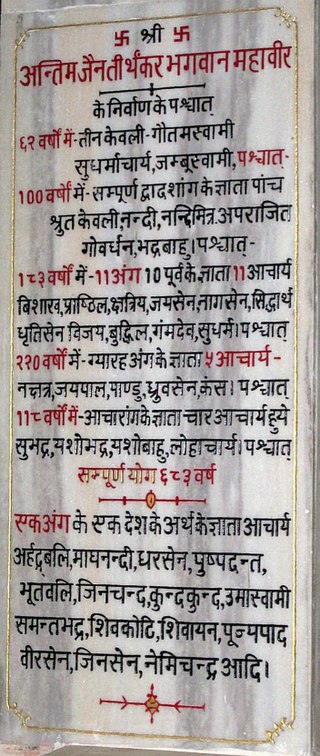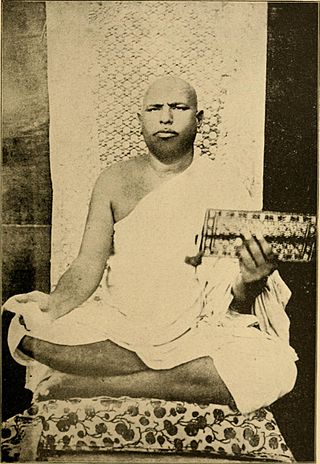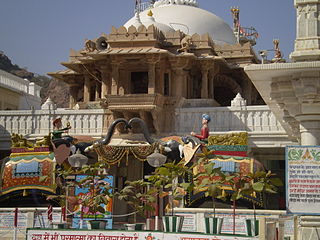
| Part of a series on |
| Jainism |
|---|
 |
Kharatara Gaccha is one of Śvetāmbara Murtipujaka Gacchas. It is also called the Vidhisangha (the Assembly) or Vidhimarga (Path of Proper Conduct), as they regard their practices as scripturally correct. [1] [2] [3]

| Part of a series on |
| Jainism |
|---|
 |
Kharatara Gaccha is one of Śvetāmbara Murtipujaka Gacchas. It is also called the Vidhisangha (the Assembly) or Vidhimarga (Path of Proper Conduct), as they regard their practices as scripturally correct. [1] [2] [3]
Kharatara Gaccha was founded by Vardhamana Sūri [2] (till 1031 CE). His pupil, Jineshvara (the author of Nivvāṇalīlāvaīkahā), got honorary title 'Kharatara' (Sharp witted or Fierce) because he defeated Suracharya, leader of Chaityavasis in public debate in 1024 CE at Anahilvada Patan. So the Gaccha also got his title. [2] Khartara also means that "which is beyond" (tara) "purity" (khara), that is, being upright with the absolute truth, by following the religious scriptures without deviation (Jain Agamas) as it is. Another tradition regards Jinadatta Suri (1075―1154) as a founder of Gaccha. [2] [4]
Jinavallabha realised the difference between texts and words of teachers and put emphasis on sacred texts in Kharatara doctrine in the eleventh century. He wrote the Crown of Assembly. [1]
The following four are known as Dada Guru in the sect and are venerated as spiritual guides. [5]
Kharatara ascetics regard their practices as scripturally correct. They follow basic Śvetāmbara canon and works of other Kharatara teachers. [1]
Ascetics: 193 nuns, 19 monks in 1986 [1] or 50-75 monks and 300 nuns. [2] Large number of its lay followers reside in Rajasthan and West Bengal states of India. [2] [1]
Several members of Kharatara Gaccha were notable writers:

The Śvetāmbara is one of the two main branches of Jainism, the other being the Digambara. Śvetāmbara in Sanskrit means "white-clad", and refers to its ascetics' practice of wearing white clothes, which sets it apart from the Digambara or "sky-clad" Jains whose ascetic practitioners go nude. Śvetāmbaras do not believe that ascetics must practice nudity.

Samprati was the 5th Emperor of the Maurya Empire. He was the grandson of 3rd Mauryan Emperor Ashoka and the son of Kunala.He succeeded his cousin, 4th Mauryan Emperor Dasharatha, as emperor of the Maurya Empire. According to Jain tradition he built 1,50,000 Jain derasars and made 1,50,00,000 Jain idols. He was also believed to have taken an oath to dig the foundation of a new Jinalaya every day and would not do navakrashi (breakfast) until it was completed.

Sthānakavāsī is a sect of Śvetāmbara Jainism which was created in the medieval era. The Sthanakvasi, whose name refers to the sect’s preference for performing religious duties at a secular place such as a monks’ meetinghouse (sthanak) rather than at a temple, is different from the Murtipujaka sect in that it rejects idolatry. It believes that idol worship is not essential in the path of soul purification and attainment of Nirvana/Moksha. Sthānakavāsī accept thirty-two of the Jain Agamas, the Śvetāmbara canon, contending that the scriptures make no mention of idol worship and temples. According to the sect, Mahavira himself never endorsed idol worship, and they argue that such practices were borrowed from other religions by the Murtipujaka Jains.

Mūrtipūjaka, also known as Derāvāsī ("temple-dweller") or Mandir Mārgī, is the largest sect of Śvetāmbara Jainism. Mūrtipūjaka Jains differ from both Śvetāmbara Sthānakavāsī and Śvetāmbara Terāpanthī Jains in that they worship images of the Tīrthaṅkaras. Mūrtipūjaka may also generally describe members of both the Śvetāmbara and Digambara traditions who use idols (mūrti) in their worship (pūjā).
Tapa Gaccha is the largest Gaccha of Śvetāmbara Jainism.

A Dādābāḍī is a type of shrine, usually located near a Jain temple, and dedicated to one of the four Dādā Gurus revered by the Kharatara Gaccha sect of the Śvetāmbara Jains. The most notable shrines are in Ajmer, Malpura and Mehrauli. The four Dādā Gurus are Jinadatta Sūri, Jinachandra Sūri Maṇidhārī, Jinakuśala Sūri and Jinachandra Sūri II.

Jainism is a religion founded in ancient India. Jains trace their history through twenty-four tirthankara and revere Rishabhanatha as the first tirthankara. The last two tirthankara, the 23rd tirthankara Parshvanatha and the 24th tirthankara Mahavira are considered historical figures. According to Jain texts, the 22nd tirthankara Neminatha lived about 84,000 years ago and was the cousin of Krishna.

A Pattavali, Sthaviravali or Theravali, is a record of a spiritual lineage of heads of monastic orders. They are thus spiritual genealogies. It is generally presumed that two successive names are teacher and pupil. The term is applicable for all Indian religions, but is generally used for Jain monastic orders.

Acharya Vijayanand Suri, also known as Atmaramji of Gujranwala, was the first Swetambar Murtipujaka Jain monk in modern times to receive the title of Acharya. Born and raised in Punjab, he was initiated as a Sthanakvasi monk and later joined the Murtipujaka tradition. He travelled extensively in Gujarat, Rajputana and Punjab; he organised and reformed Jain community, ascetic orders and literature. He wrote several books in Hindi and was invited to the first World Parliament of Religions in 1893 which was attended by Virchand Gandhi later.
Jinaratnasuri (Jina·ratna·suri; Hindi: जिनरत्नसूरी was a Śvetāmbara Jain scholar and a monk of Kharatara Gaccha, who composed Līlāvatīsāra. He completed his poem in the year 1285 CE in Jabaliputra, western India,. It is an epitome of a much larger work called Nivvāṇalīlāvaīkahā composed in Jain Maharashtri, a Prakrit language, in 1036 by Jineshvarasuri, also a Jain monk.

Jainism is an Indian religion which is traditionally believed to be propagated by twenty-four spiritual teachers known as tirthankara. Broadly, Jainism is divided into two major schools of thought, Digambara and Śvetāmbara. These are further divided into different sub-sects and traditions. While there are differences in practices, the core philosophy and main principles of each sect is the same.
Gaccha, alternatively spelled as Gachchha, is a monastic order, along with lay followers, of the image worshipping Murtipujaka Śvetāmbara sect of Jainism.

Vividha Tirtha Kalpa, originally named Kalpa-pradeepa, is a widely cited Jain text composed by Jinaprabha Suri in the 14th century CE. It is a compilation of about 60 Kalpas (sections), most of them give the accounts of major Jain Tirthas.
Prabandha is a literary genre of medieval Indian Sanskrit literature. The prabandhas contain semi-historical anecdotes about the lives of famous persons. They were written primarily by Jain scholars of western India from 13th century onwards. The prabandhas feature colloquial Sanskrit with vernacular expressions, and contain elements of folklore.

Nakodaji Tirth is a major Śvetāmbara Jain tirth of Tirthankara Parshwanatha in the Indian state of Rajasthan, located between the villages of Vikrampura and Nakoda in Barmer District. The temple houses the icon of Nakoda Bhairava, a prominent Śvetāmbara guardian deity.
Udaya-prabha Sūri was a Śvetāmbara Jain monk and writer from the Vaghela kingdom of present-day India. He was a member of the literary circle of the minister Vastupala, and wrote several Sanskrit-language works.
Vādikavi Ācārya Bappabhattisuri Mahārāja Sāheb was a Śvetāmbara Jain ascetic in the 8th century CE. He was an eminent poet, philosopher, reformer, researcher, and a child prodigy. Apart from his literary contributions, he is best known for his scriptural debates and the reforms he brought about in the iconography of Tirthankara idols sculpted and owned by the Śvetāmbara sect of Jainism.

Aryarakshitsuri was Śvetāmbara Jain monk and the founder of the Achal Gaccha of the Śvetāmbara sect of Jainism. He was a contemporary of Hemchandrasuri and is said to have met him.

Śāsana Samrāt Ācārya Nemisuri Mahārāja Sāheb was a 20th century CE Śvetāmbara Jain ascetic, philosopher, researcher, reformer, and the head of the Tapa Gaccha. He is best known for his efforts in preserving the Jain literature and protection of major pilgrimage sites such as Palitana temples, Girnar Jain temples, and Taranga Jain temples.